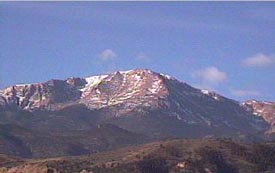 The picture
on my kitchen calendar shows a mountain pass in Colorado. With July at the
turn of the page, I also think of patriotic connections with "purple
mountain majesties above the fruited plain." The author of
"America the Beautiful" had been impressed by the view from
Pike's Peak. In addition, a family I know just came home from Colorado,
where visiting with grandparents and other relatives is not the only
attraction for the annual summer trips.
The picture
on my kitchen calendar shows a mountain pass in Colorado. With July at the
turn of the page, I also think of patriotic connections with "purple
mountain majesties above the fruited plain." The author of
"America the Beautiful" had been impressed by the view from
Pike's Peak. In addition, a family I know just came home from Colorado,
where visiting with grandparents and other relatives is not the only
attraction for the annual summer trips.
My uncle and
aunt from southern Illinois used to vacation in Colorado, too. Since they
lived at a distance, I thought almost anything they did was a notch above
ordinary activities and concluded that it must be a privilege to go and
see the mountains. Actually, I don't recall many details, except that my
uncle took pictures of chipmunks.
My parents
had also visited Colorado. My father, a Nebraska native, made a special
trip west before heading east to Illinois, where he met my mother. His car
didn't make it up Pike's Peak at first, so he got a new fuel pump and
tried again. Our family photo albums show him sitting next to a sign for
elevation 12,110 feet above sea level.
 Pictures
from a few years later show both my parents in Colorado. They traveled to
the mountains as part of their wedding trip. Mom said that when she first
saw the mountains, she didn't realize what she was seeing, because it
seemed more like a mist. Up in the mountains, there was snow, although it
was summer. She remembers how far down it looked at the sides of the
narrow, winding roads. At one place it seemed to her that the water in a
stream was flowing uphill.
Pictures
from a few years later show both my parents in Colorado. They traveled to
the mountains as part of their wedding trip. Mom said that when she first
saw the mountains, she didn't realize what she was seeing, because it
seemed more like a mist. Up in the mountains, there was snow, although it
was summer. She remembers how far down it looked at the sides of the
narrow, winding roads. At one place it seemed to her that the water in a
stream was flowing uphill.
I've never
visited Colorado myself, though I grew up in a bordering state. The
closest I came was a weekend trip to the Nebraska Sandhills at about this
time of year. I was told that on the way we'd be passing the last grain
elevator before ranch country, which put me farther west than I'd ever
been before. It was also exciting to cross into Mountain Time, especially
since it gave us an extra hour for the Friday evening drive.
Going west
has been a major part of American history. Europeans came west across the
ocean, and America expanded from east to west. In the 1800s, newspaper
publisher Horace Greeley of New York popularized the phrase "Go west,
young man," and sponsored a farming colony in Colorado.
I
incorporated the westward progression into my thinking at an early age. I
didn't take it to mean that I should move farther west; I took it as an
affirmation that I was in the right place, in the western part of the
Midwest. To me, the western plains were the destination of the American
pioneer spirit, of people who didn't stay cooped up in the cities but
followed the wagon tracks, braved the hardships of the prairies and
endured. And somewhere out there beyond the western horizon, the endless
plains came to a magnificent climax in the Rocky Mountains, a symbol of
America and the American dream. At least, that was how I imagined it to
be.
 I had to
adjust my thinking when our family moves turned out to be in other
direction, but I suppose moving east isn't inherently an un-American
activity.
I had to
adjust my thinking when our family moves turned out to be in other
direction, but I suppose moving east isn't inherently an un-American
activity.
Time showed
me unexpected vistas in different places. I climbed sand dunes near Lake
Michigan instead of in Colorado and marveled at unusual rock formations
near the southern Illinois version of the Garden of the Gods. Once I took
a flying leap to the West Coast and saw a few of the mountaintops at
least.
 The Colorado
in my mind remains a mixture of imagination, photographs I’ve seen and
information I’ve read. The names are tantalizing, stark and full of
mystique: the Black Canyon of the Gunnison, Calamity Camp, the Mesa Verde
cliff dwellings, the Florissant fossil beds, Horsethief Canyon, Rim Rock
Drive, the Uncompahgre River. With the original Spanish,
"Colo-RAD-o" mellows to "Colo-RAH-do," the river
colored red. One trail leads to Exclamation Point.
The Colorado
in my mind remains a mixture of imagination, photographs I’ve seen and
information I’ve read. The names are tantalizing, stark and full of
mystique: the Black Canyon of the Gunnison, Calamity Camp, the Mesa Verde
cliff dwellings, the Florissant fossil beds, Horsethief Canyon, Rim Rock
Drive, the Uncompahgre River. With the original Spanish,
"Colo-RAD-o" mellows to "Colo-RAH-do," the river
colored red. One trail leads to Exclamation Point.
Sometimes
dreams – American or otherwise – don't completely survive the
realities, but the mountains should still be there if I ever decide to go.

